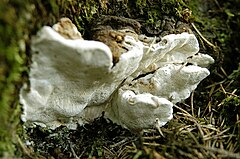Heterobasidion
| Heterobasidion | |
|---|---|
 |
|
| Heterobasidion annosum | |
| Scientific classification | |
| Kingdom: | Fungi |
| Division: | Basidiomycota |
| Class: | Agaricomycetes |
| Order: | Russulales |
| Family: | Bondarzewiaceae |
| Genus: |
Heterobasidion Bref. (1888) |
| Type species | |
|
Heterobasidion annosum (Fr.) Bref. (1888) |
|
| Species | |
|
H. abietinum |
|
H. abietinum
H. amyloideum
H. annosum
H. araucariae
H. arbitrarium
H. australe
H. ecrustosum
H. insulare sensu typi
H. irregulare
H. linzhiense
H. occidentale
H. orientale
H. pahangense
H. parviporum
H. rutilantiforme
H. tibeticum
Heterobasidion is a genus of basidiomycetes in the family Bondarzewiaceae. Species in this genus include forest decay fungi that may be pathogenic and cause tree decline and mortality. The genus can be identified from its shelf-like polyporous fruiting bodies. Mating studies in the late twentieth century and genetic studies in the early twenty-first century have described several new species and replacing some of the original names. As a result, two former Heterobasidion species, H. annosum and H. insulare, have been expanded into species clusters.
Heterobasidion annosum sensu lato is a collection of species that cause Annosum root rot to forest trees across the Northern Hemisphere. These species can be saprotrophic or necrotrophic, colonizing decayed heartwood or live roots causing mortality. Several tree species have been identified as hosts but evergreen trees such as pine are most affected. Annosum root rot is a serious issue to forest health due to tree mortality, decreased lumber volume and quality, and carbon sequestration. This species cluster is one of the most intensively studied forest pathogens, becoming the first basidiomycete forest pathogen to have its genome sequenced in 2012.
...
Wikipedia
